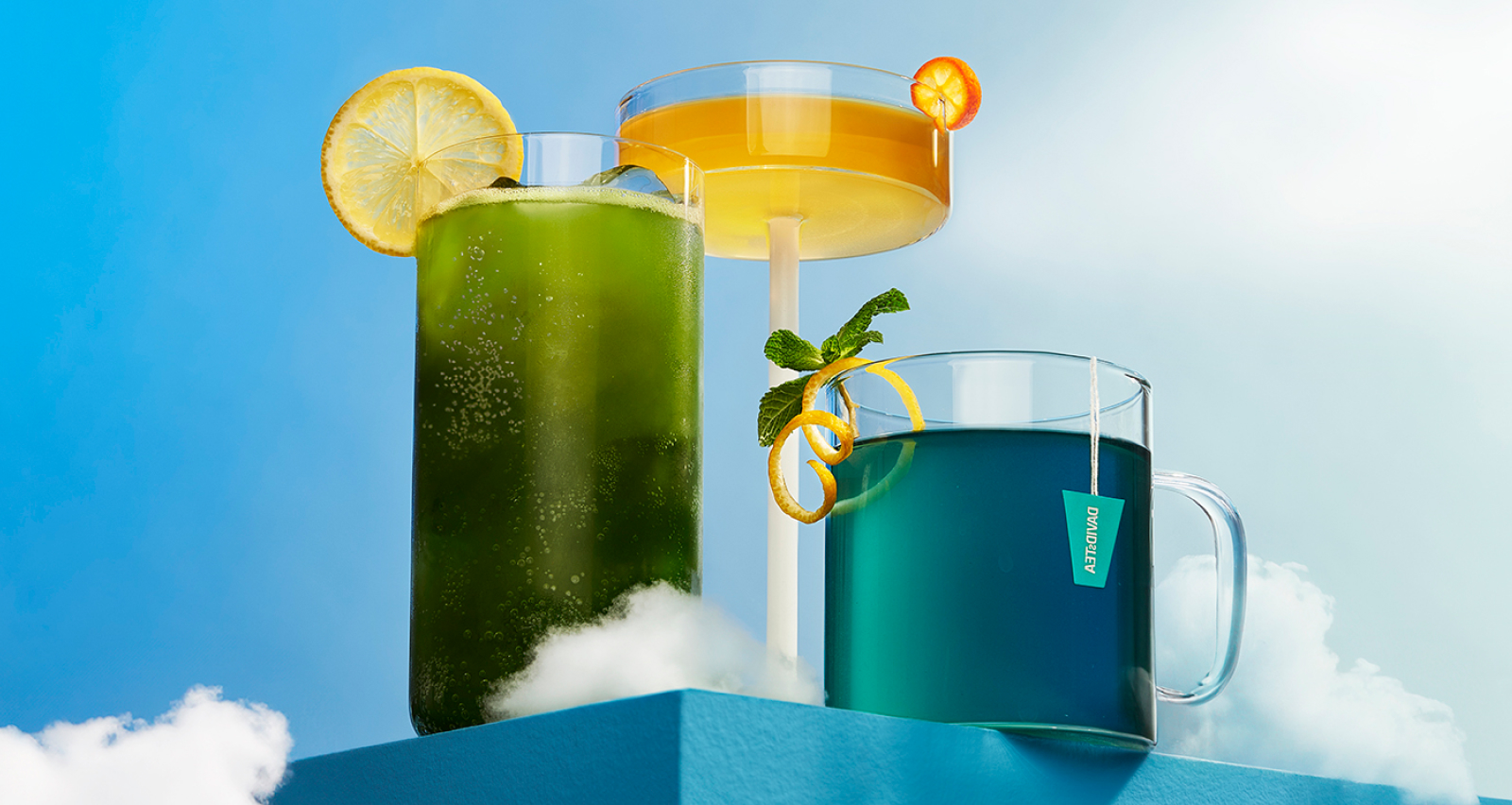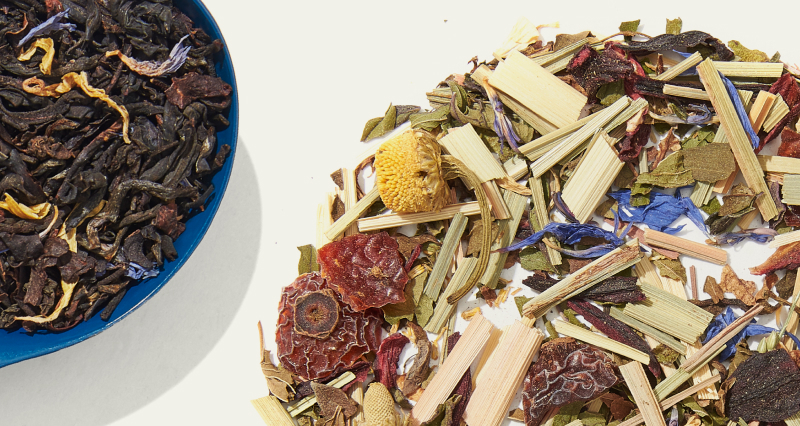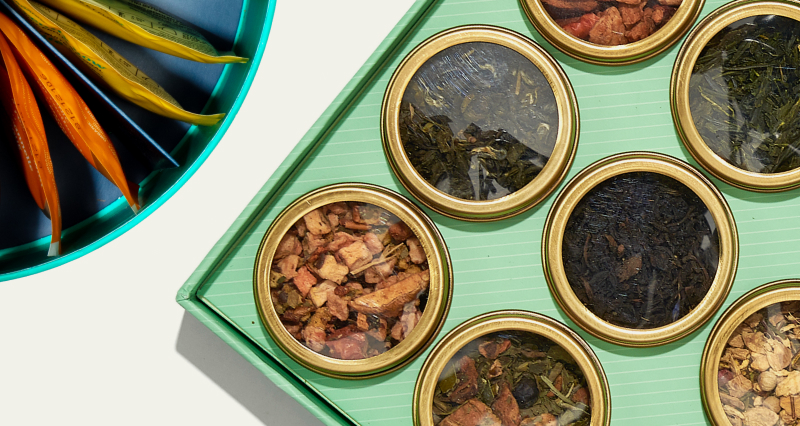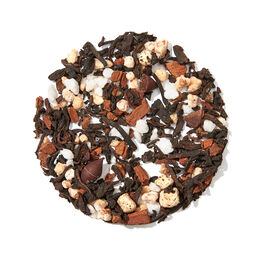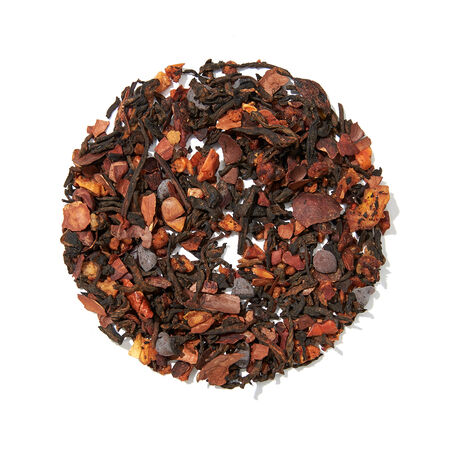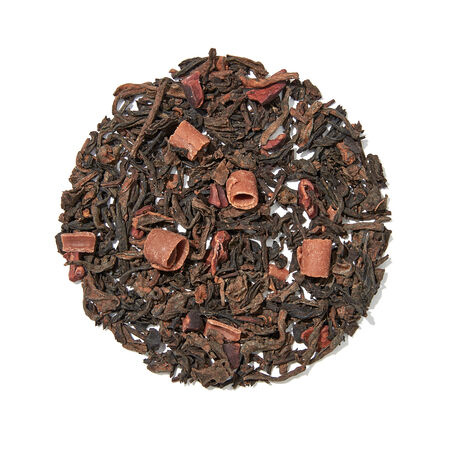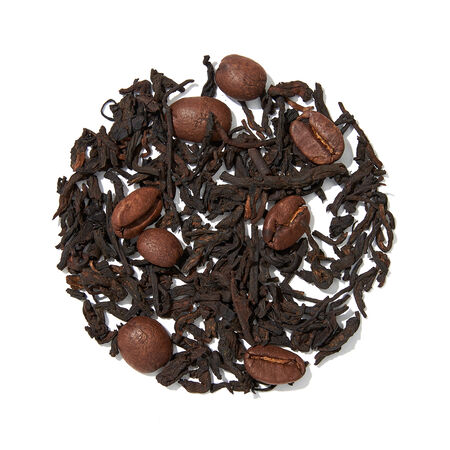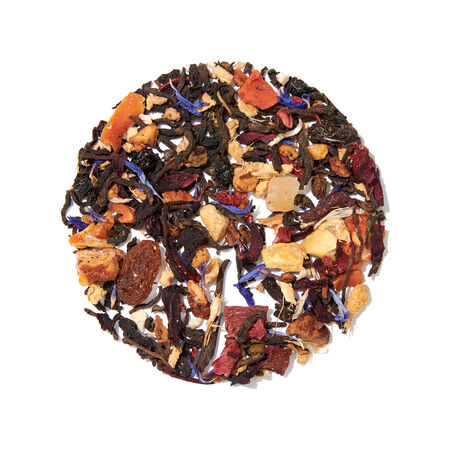season 2 | ep. 12
pu’erh tea, an
enduring love story
with Kelly Miller

steeping together podcast
- season 2 | Ep. 12
pu’erh tea, an enduring love story
with Kelly Miller
episode transcript
Marika de Vienne 0:19
Welcome everyone to a special mini episode of Steeping Together, where we explore a specific topic within the vast world of tea with a tea enthusiast. I'm your tea-obsessed host Marika, and I cannot wait to dive right into today's topic. So, the world of pu’erh tea is vast, and we mean huge, ancient, sometimes a bit scary. This most ancient way of producing tea has intrigued the world for literally centuries now and continues to captivate and enrapture. But why? This is the question I have put before our guest today, Kelly Miller. Let's see if we can figure out the mystery of pu’erhs appeal and staying power over 3000 years in a 20 minute episode. Welcome, Kelly!
Kelly Miller 1:09
Hi. No pressure.
Marika
No pressure at all. Exactly. Look, I cannot think of anyone better than you to join me on this very quick, but important journey. You want to just introduce yourself really quickly for anyone who would have missed your previous appearance?
Kelly Miller 1:28
Yeah, for sure. My name is Kelly, I work here at DAVIDsTEA in the Research and Development department. I obviously drink a lot of flavoured tea. But I also drink a lot of straight tea and a lot of pu’erh.
Marika de Vienne 1:43
Exactly. And it is for that reason that I reached out to you specifically, when it came to topics that we had for these mini episodes, one of them was pu’erh. It's one of the most intriguing and as I said, most ancient forms of tea on the planet. And out of all the people that I know, you're probably the person who drinks pu’erh the most regularly, maybe not the most in terms of quantity. But I follow you on Instagram and I do see pu’erh crop up a bit more than anyone else in this office. And that's why I asked you to join me on this quest.
Kelly Miller 2:21
Yeah. When you asked, I was a little hesitant.
Marika
That’s one word for it.
Kelly
I mean, I absolutely drink a n of pu’erh, you're right. I certainly post about it quite a bit. But it's a big category. And there are people who've been studying pu’erh, and only pu’erh, exclusively drinking and learning the intricacies and nuances of this tea type longer than I've been alive.
Marika de Vienne 2:52
Excellent point.
Kelly Miller 2:55
And so that's intimidating.
Marika de Vienne 2:57
Yeah, for sure. It's really intimidating. And I understand your reticence. This is the most ancient form of tea production to our knowledge. It is being studied at universities throughout the world. It is a really big ask to task anybody with to discuss pu’erh, certainly in 20 minutes in a short recap of what pu’erh is. But the question that I wanted to answer was not necessarily the production method of pu’erh, its place in the economic history of China, how it's been produced differently over the past 3000 years. The question I'm asking is, why is this still so popular? What's the staying power? What's the hook? What's the love for this tea? And in order to answer that, yes, I probably could have sought out an academic or somebody who studied like the moisture content of pu’erh throughout the ages. But I really wanted to talk to someone who has taken pu’erh to heart and taken it as part of, if not a daily routine, certainly a weekly routine. Certainly something that you drink a lot, because understanding that pull and that desire and that appreciation is more interesting to me in this moment than studying it as a cultural artefact or any other way. So that's why I've asked you to come and I appreciate your hesitation. But I appreciate much more your courage in going okay, fine, I’ll do it!
Kelly Miller 4:33
We’re gonna work through it.
Marika de Vienne 4:37
We’re gonna work through it. So we're not here to give a history lesson but we do need to kind of explain what pu’erh tea is. So pu’erh tea is made with the leaves of the Camellia sinensis plant as are white, green, oolong and black teas. All comes from there. But because this tea is fermented, as opposed to oxidised like those other types of tea, it has a very particular flavour. It is also the tea that was more or less first commercially produced in China 3000 years ago, perhaps even dating back longer than that most certainly, because of its process. Oxidation didn't exist thousands of years ago but fermentation did. And this tea was then packed into cakes to make it easier to transport on the Tea Horse Road, all throughout Asia. And that's how most people consumed tea for the first few thousand years of this beverage. It's daunting to even think about the impact that this tea has had and how in the West, it's only become more popular, I'd say over the past 15 years. Before 20 years ago, you didn't really see pu’erh. Certainly in North America, nobody really had an idea of what it was. And now I think people are starting to acclimate to its flavour profile, to its history, to its cultural impact a little bit more.
Kelly Miller 6:07
Yeah, without getting into I think again, all of the the minutia of it. There was like the pu’erh market bubble pop that happened. This is a type of tea that historically is very expensive and is traded similar to how you would trade stock. And that was a barrier for I think a lot of people in terms of accessibility and access. And there was this, you could almost compare it to a recession, where this bubble burst. And for the first time, almost truly, in North America, it became something that anyone could get accessibly. And I think that is a huge contributing factor to why it is growing in awareness.
Marika de Vienne 6:56
Absolutely true. And there were also laws in place in China. So this type of processing of this type of tea originated in Yunnan, China, still primarily produced in Yunnan, China. Not to say that there aren't productions in different tea producing countries or regions of China, but I think when you say pu’erh tea you associate it very directly with Yunnan Province, where the Camellia sinensis plant was initially discovered, for lack of a better term. There were many laws in place up until about 1979, and some of those laws are still in place in China, where the process of pu’erh tea cannot be disclosed to outsiders. That how it is traded cannot be disclosed. I mean, there was a–it was a state secret, for lack of a better term, for a good portion of the 20th century. So there was a reason in the West we didn't have access to it. And now it's opening up a lot more and there are a lot more people who are into it. I think another reason that it took so much time to get a hold on people's palates here in the West, is its flavour profile. So as we said, pu’erh tea is fermented, there are two basic categories. You have shou pu’erh and you have sheng pu’erh, essentially, one is more raw and one is more ripe. That is a direct translation of those two words. The raw variety, the sheng variety is greener, more astringent. And I always have a hard time steeping sheng pu’erhs, I feel like they're very very precocious and they need a great deal of attention. The right temperature, the right steeping time, the right steeping tools, but they give a very refreshing and interesting take on fermented tea. And then you have the ripe ones. The shou pu’erhs. How would you describe the flavour, Kelly, of a show pu’erh? If you had to encompass this entire category in a few words, what would you say?
Kelly Miller 8:58
In the simplest terms, I think the way I think of it is a black tea but more earthy. But really shou as a category has a lot of deeper notes, heavier notes, it's very strong and robust. I think of the flavours and the aromas of nature. So if you picture being in a forest it's that smell of the undergrowth and the moss, the woods, the rich rich soils, the camphor of the trees, and while the flavour can absolutely vary like any tea type or tea category that I think is the most characteristic.
Marika de Vienne 9:42
I agree with that description. To me it's always been, because shou pu’erhs, the way they produce it–and I'm going to give a synopsis, a very quick snapshot of this process–is essentially the leaves that are picked are quite mature on the plant depending on the type of shou you want to make. It's not necessarily young buds, they've got a few months on them. Then they are literally put into piles and they have extra moisture added to them, be it through water, a sprinkling, there are many different processes. And then they're covered or put into, you know containers and left to compost. Essentially what we're talking about is a form of composting. And depending on the kind of shou you want to make, maybe you do that for a few hours, maybe you do that for a few days, but you're always turning it over and then adding more moisture, and then you'll stop the fermentation process either through the application of heat or pressing it into bricks. A lot of pu’erh teas are presented in the form of disks. Large, compact discs of tea.
Kelly
Think of Frisbee.
Marika
Yeah, it's a Frisbee. You're right, you're totally right. It looks like a Frisbee. I mean, you can also find it in the shape of a genuine brick. You can find it compressed into balls. There are many different ways to compress these pu’erhs and shengs are as found compressed as shous are. But that step of wetting the leaves and allowing the tea to compost really gives you that feeling of walking through a forest and smelling all the wet wood. And it's so good. So good. But it is an acquired taste. So I lived in Yunnan for three years. I drunk–I have drunk so much pu’erh you have no idea. I loved it while I was there. I enjoyed the variety and the different flavours. I have to admit though, upon returning to North America, I drink pu’erh probably the least after white tea, of all the categories of tea that are out there. What do you think is its staying power? Because to me, I associate it to a time and a place and an access to a variety that I no longer have living in North America. What do you attribute pu’erhs continued staying power to?
Kelly Miller 12:01
I really don't think it's just one thing. I mean, personally my journey with pu’erh was anything but linear. I tried almost every other type of tea you can possibly imagine before I got around to trying to trying pu’erh. It was scary. It was the one type of tea that I felt the most intimidated to try and the most unequipped to appreciate. And when I did try it, I didn't like it. And so then I felt “lesser than” or you know, maybe there was something wrong with me for not understanding this type of tea. And it took a long time of slow trial to get to a point where my palate was accepting of the flavour and then craved the flavour and tolerated the flavour. But what was really important, I think, is that I didn't push myself there, I didn't try to force myself into enjoying it. I had the curiosity and the intrigue, and I know the breadth of flavour that was offered through pu’erh. So I kept revisiting it. But I really, really wouldn't recommend to anyone drinking it just for the sake of you know, drinking it, if you're not, if you're not liking what you're making.
Marika de Vienne 13:17
Don't force yourself! And I think certainly, I don't actually know what the conversation in terms of health benefits associated with pu’erh are in Canada, ironically. But when I was living in China and this is around 2008, 2009, at the height of pu’erh purchasing within China itself, it was marketed as the absolute number one metabolism booster. You were going to lose weight, you were going to glow from the inside out. And that attracted a lot of people within China within the internal market to purchase pu’erh. Now, full disclaimer, we are not doctors, I do not recommend tea for anything regarding health ever. I will anecdotally say that I drink pu’erh every single day, several cups a day for three years, and I've remained as voluptuous as ever. I never said a pound! Not to say that this tea is not good for you. But I think it really is marketed a lot as a health tea, a tea should drink for your health. And to your point people push through and insist on drinking it because it's going to make them healthier but it's definitely not making them happier and that's quite unfortunate.
Kelly Miller 14:32
So when I finally did start drinking pu’erh a lot more regularly and started actually getting to a point where I wanted to invest in buy in cakes and not just know samples or things I was getting like from friends and trades or you know, when available. For me it was shou and I think that makes a lot of sense because other than pu’erh the type of tea I drink the most of is black tea. And so it was just a very natural bridge for me. I still absolutely love black tea, there are a lot that are part of like my daily routine, my weekly routine, that will always be part of that tea rotation. But there's something to be said for how black tea over time will lose flavour, it does go stale, like any other tea. Not expire, but just you know, lose freshness over time. Pu’erh does not do that, pu’erh ages over time, and so it will either maintain its flavour or change and develop flavours in new ways. And that was appealing to me, I could buy more pu’erh and I didn't necessarily have to worry about drinking it super quickly. Or you know, I am a person who is intrigued and drawn to diversity of flavour. And there's something magical about the idea of buying something at one point, and getting to watch its evolution over time. And grow with that evolution and have your palate, you know, reflect and change with that. That spoke a lot to me. There's the earthiness factor. I am super introverted, and I know a lot of other people who are introverted as well. And there's something kind of nice about taking a drink or a beverage like a shou that has all of these rich notes of soil and woods and things that remind you of being out in nature and getting to bring that inside with you. I personally find that very meditative. And it became for me a form of like self care, and just a really grounding moment that I get to incorporate into my week every week.
Marika de Vienne 16:48
Yeah, I really like how the tea has done that for you, especially since I mean, I know you steep your pu’erh different ways. You'll steep it in an infuser. I don't know that I've ever seen you make a teapot of pu’erh, but I've certainly seen you make Gong Fus or Yi Xing of this tea, the preparation and the method and then also the flavours that you're describing of being out in nature, being more grounded. All of that creates a really beautiful moment and a really nice gift that you can give yourself. The other thing you said, which is really important to notice, that pu’erh, at least certain pu’erhs, can be aged exactly in the same way that one would age a red wine, you can keep it for several several several years. And just a little tidbit for anyone going to a wedding this summer, my favourite gift to give a new couple is a pu’erh from the year they were married and in the card tell them that every year on their anniversary, they should make each other a cup of pu’erh tea and see how the tea has changed and evolved over time, much like their relationship has. It's a fantastically cheap way to be extremely romantic!
Kelly Miller 18:04
I think this will say a lot about the kinds of friends both you and I have. But one of my friends recently, I guess not recently, but they commissioned pu’erh pressings specifically for them for their wedding. So they bought a tong–tong in this case is another way of saying like a series of cakes. So if, you know your cake is a Frisbee essentially, picture that in your head, a tong would be five Frisbees.
Marika de Vienne 18:35
Right, and it's a unit of measurement. It's the ancient unit of measurement for weight in China and yeah, a tong is five pu’erh cakes usually wrapped in like, I want to say bamboo leaf right? Bamboo leaf.
Kelly Miller 18:49
Bamboo leaf, yeah. And so they commissioned that for themselves so that they will have this wedding pu’erh to drink together for the rest of their lives.
Marika de Vienne 18:57
That is yes, I mean our friends are definitely more on the tea drinking side, but I have also offered this to the coffee drinking couples or throuples in my life and they seem to enjoy it a great deal. What tips Kelly, do you have for people interested in trying pu’erh tea because, and I say tips not in terms of what flavours should they seek out, but there is a particular steeping method, there are some tricks that I think one should be armed with before they dive fully into the world of pu’erh because I think we're used to loose leaf teas or tea bags. But what if you're, you find yourself confronted with a brick, like where do you even start? What are the tips that you would give someone so they could get over those initial hurdles and then decide for themselves whether or not they like this flavour?
Kelly Miller 19:46
Well I actually, I do think flavour is something you should keep in mind first, ironically, to kind of go against that. Think in your head as a consumer what type of tea are you naturally more drawn towards? Is it black teas, Is it green teas or lighter oolongs? That I think is a really good benchmark because for me it was black teas and so it just made sense that the easier access point was shou which is a little more closer and flavour to black tea. I don't drink a lot of green tea and so of course when I first started trying pu’erh and I was trying sheng, it wasn't appealing to me because it is a lot more directly comparable to green tea. But if you are a drinker of green tea shou might not be the right place for you to start. You might want to go on the other end of that spectrum.
Marika de Vienne 20:38
That's an excellent point.
Kelly Miller 20:39
So I do think flavour should be a consideration. Try something closer in the wheelhouse of what you're already drinking. Another easier way to get into is trying a flavoured pu’erh first. I know for some people that idea seems blasphemous! As Marika looks at me like I’m…
Marika de Vienne 21:01
I defer to your expertise and experience and I will keep my opinion to myself.
Kelly Miller 21:10
You gave me a look like I kicked a puppy.
Marika de Vienne 21:13
No! Look, I think you're absolutely right. I think for a gateway or an entry point for a great many tea bases are flavoured. I think a lot of people start drinking black tea because they grew up drinking Earl Grey. I think a lot of people start drinking green tea because the have an affinity for jasmine teas. There's no hiding the fact or ignoring the fact that flavoured teas allow you to appreciate a base later on. As we've said to each other previously, I started exclusively really with straight teas growing up. So it's very difficult for me to hear that you should start with a flavoured pu’erh. But I will let you continue.
Kelly Miller 21:48
I just mean if the idea of drinking something that tastes like earth or wood is unattractive to you. And I think that's fair because it is unattractive to a lot of people, when we throw out words like fermented or compost or even things like camphor, which I think a lot of people don't even know what that word means. And really, it's that, like feeling–think like a really strong peppermint is very camphorous.
Marika de Vienne 22:14
I always think of Vicks Vaporub. When I think of–when I'm explaining camphor, it's like that first inhale after you've spread it on your chest. That's camphor.
Kelly Miller 22:22
So when we throw out words like that, that either are unfamiliar or unappealing sounding, it really can be a great bridge to try something flavoured first so that you’re least coupling that with something that you know you like or that is familiar, and you kind of grow accustomed to that and get a baseline for whether you're like ready to dive into that zone. Because it can be too much. It was too much for me when I first tried it, and I'm glad I revisited it. But if someone had just ripped that band aid off for me initially like that, I think I would have not gone back necessarily.
Marika de Vienne 23:04
Right, agreed, agreed. And I think another thing that we should mention is, I personally would not recommend starting with a brick of pu’erh, if only because it's a large quantity of tea. We're talking about 357 grammes per traditional pu’erh disk. And then you need a unique and interesting tool to break this brick apart. Now it’s not expensive. It's just not found at the corner store.
Kelly Miller 23:31
Yeah, so that would be the other set of tips. Well, once we move past flavour, how do you actually go about brewing your pu’erh? I would honestly recommend buying samples or I think another really accessible way to introduce yourself to pu’erh– sheng or shou–is looking for things called tuo chas. Tuo chas essentially is just like a small version of that cake or that brick. And they can come in a couple different shapes. The traditional one is almost like a cylinder with a little divot pushed into it. But there's also coins, literally just think of chocolate-covered coin and now replace that with tea. That is like the size and the width we're talking. Or dragon balls, and that's just like a round version of that, smaller than a ping pong ball but kind of in that range. And those can be really good points because they're already pre-measured out for you, something of that size is usually right for about a teapot, a Western style like large teapot. It's going to be perfect. If you don't want to do a teapot you can, like the coins are really good because you just snap them in half.
Marika de Vienne 24:51
Yeah and just make sure that the coins are not decorative because they do make decorative tea coins with a special paint lacquer on them. You don't want to infuse that. So make sure it's not the pretty ones. It's just a coin shape, not a coin pressed, if that makes any sense.
Kelly
Good point.
Marika
So yeah, go for your smaller quantities, which is something you recommended on your previous episode in how to buy teas online. Go for teas, pu’erhs that are already compressed into smaller quantities. I think it's important to note that because these tuo chas, as you say, are compressed, and you can put them in a teapot. What about rinsing Kelly? I think we need to talk about rinsing.
Kelly Miller 25:35
Rinsing is a controversial topic because not everyone wants to do that. And it's also another thing you do with most types of tea. A rinse is essentially running hot water over your tea leaf, letting it sit for a couple seconds, the amount of time definitely will vary from person to person. I've seen anywhere in the range of five seconds to a minute. When I do rinse for me, it's personally closer to that five second mark, I would say five to 20 seconds is kind of my sweet spot. I don't personally want to lose a lot of flavour. But you do want to open those leaves up. Because they are compressed and more tightly compact. You need to give them…
Marika de Vienne 26:22
Space to, space to breathe, you want to really kind of let them open up a little bit and that's going to give your tea extra body, a little bit more flavour. Yeah, when I was in Yunnan, I always saw compressed teas and pu’erhs generally being rinsed. That is the tradition there, not to say that everyone adheres to that. But after three years, I saw a few people make a few cups and I never saw anyone not rinse their pu’erh. But honestly, it was like three seconds, it was just enough to get the leaves to open up and then make a steep. And then resteeping a pu’erh, that's where you, I think you can decide how long you want your rinsing to be because every time you finish your pot or finish your cup of pu’erh, it's one of those tea bases that is extremely generous, can give you another cup, can give you another steep and every steep is unique and different. That's what I love about this tea.
Kelly Miller 27:15
Absolutely. You can even do the traditional steeping method would be Gong Fu. But you can do a modified version of that if you feel intimidated by brewing Gong Fu. If you don't necessarily have all of the traditional equipment, a really great way is to take a Nordic mug and you know, load your pu’erh into your basket infuser. And use that as your quick method to remove the tea leaves. You can use the lid it'll double over as a coaster. And we do that in the tea lab all the time where we'll do this modified version of brewing Gong Fu where we'll just do it straight in the mug and pull those tea leaves out quicker. You can experiment with the time but you know if it's your first time playing around with it, 30 intervals are not a bad starting place. Or 15 seconds, you really are going for more leaf than normal, a lot less time.
Marika de Vienne 28:12
Well, Kelly, you know, we said this was going to be 20 minutes, we've already gone over that time because this is just a category and tea family that is just so huge as we said, and so much to explore. I literally have four other questions that I wanted to ask you. I'm gonna put a pin in it. Maybe later on we'll do pu’erh part two, we'll see. But I really want to thank you for taking the time to discuss this with me because it is a fascinating topic. It's one that you and I have discussed many times before. And I just want to open the conversation to more questions and more answers.
Kelly Miller 28:47
Yeah, for sure. Thank you for having me. I hope if people have specific questions, they'll let us know through the podcast email. I think anyone in our tea department is excited to talk about any tea but really kind of demystifying this one that is so intimidating for so many people. It's something that it's definitely worth all of our times.
Marika de Vienne 29:11
Absolutely, so thank you to everyone listening to today's mini episode and Kelly again, thank you. And as you said, if you want to reach us with any comments, questions, or topics for another mini episode, you can do so at steeping.together@davidstea.com, or through our website davidstea.com. Have a great week and happy steeping everyone.
Kelly Miller

about the guest
Kelly Miller has been tea-obsessed for nearly a decade. What is the source of her obsession, you ask? It all started when Kelly visited a DAVIDsTEA store for the first time to buy a gift for a friend. Intrigued by our Birthday Cake tea, she gave it a quick sip. And just like that, Kelly, the tea sommelier, was born. THAC (Tea and Herbal Association of Canada) Certified, Kelly currently works as the Research & Development Lead at the DAVIDsTEA headquarters. Her generous and exploratory nature makes her an indispensable member of the team as she continuously pushes for new flavour innovations. Since her first introduction to the world of tea, she has tried over 10,000 teas AND her personal collection exceeds 1,500 unique teas and blends! Please give it up for Kelly, everyone!






